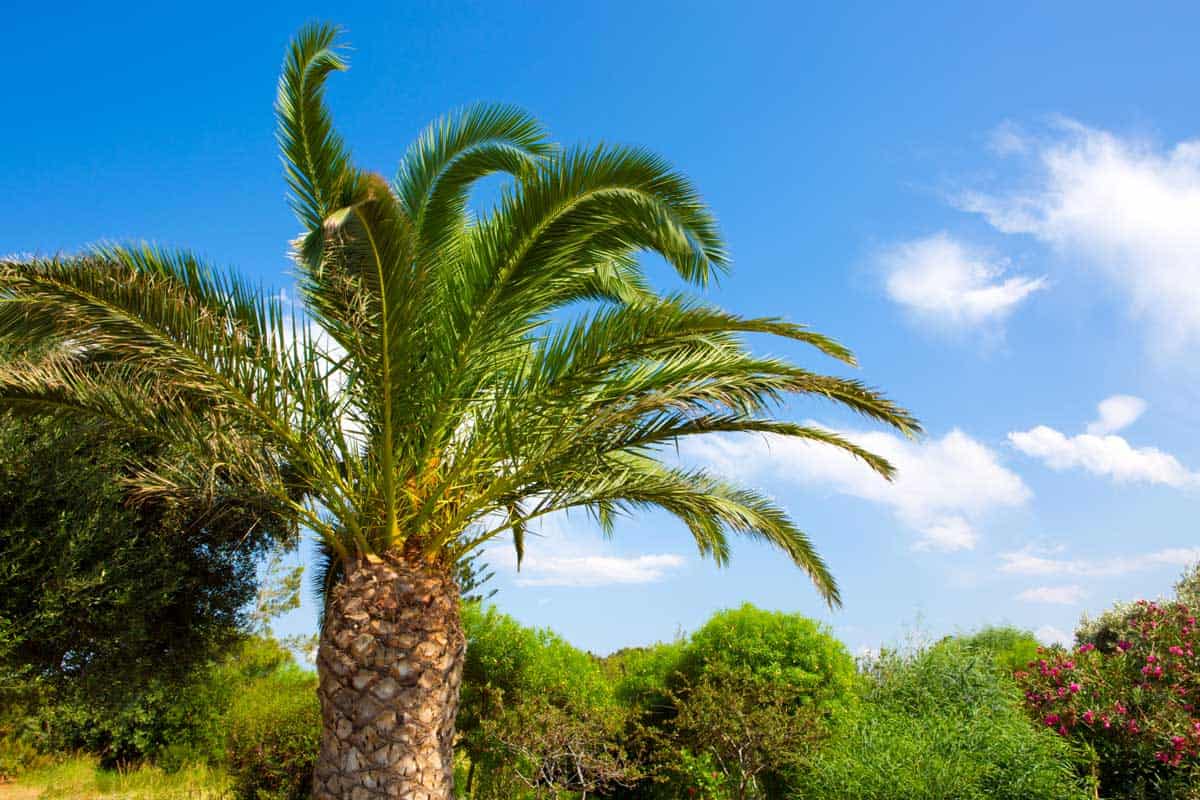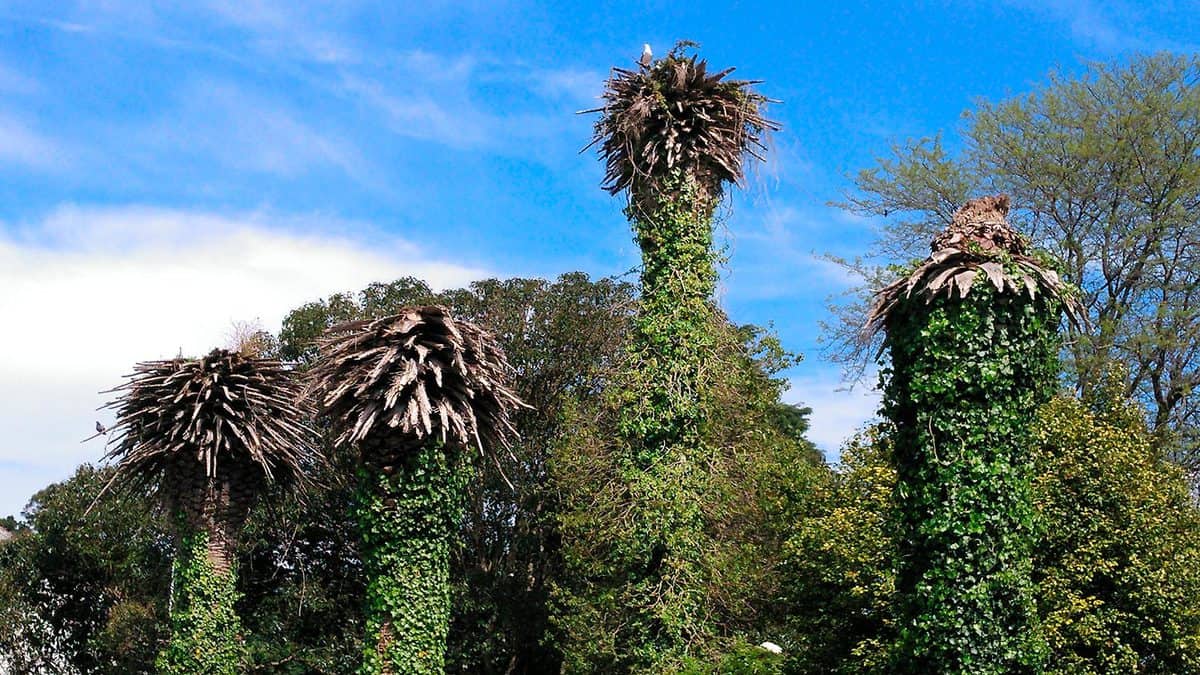 Evergreen palm trees add a burst of color to your tropical landscape all year long. But, when outdoor palm tree leaves turn brown, what can you do to replenish their lush, green color? We’ve researched the answer to learn what your palm’s brown leaves are telling you.
Evergreen palm trees add a burst of color to your tropical landscape all year long. But, when outdoor palm tree leaves turn brown, what can you do to replenish their lush, green color? We’ve researched the answer to learn what your palm’s brown leaves are telling you.
If you notice the leaves, or fronds, on your outdoor palm tree beginning to turn brown take a closer look at the tree’s environment:
- Check the tree’s water supply.
- Check if the tree is getting too much direct sunlight.
- Check the soil’s nutrient levels.
When you’ve determined the tree is getting too much or too little water, sunlight, or nutrients, you can adjust these factors to help the tree stay healthy.
As for what to do about the brown tips or brown fronds? It is ok to remove completely brown, dead fronds. But try to leave partially brown fronds or brown fronds with green stems on the tree unless they pose a hazard to the immediate area below.
Brown fronds are usually a natural part of the palm’s growth process. But discolored fronds can also signal to you that your palm tree is not getting the appropriate amount of nutrition it needs to stay healthy. Keep reading, and we’ll discuss how to best care for your outdoor palm tree to prevent and tend to brown fronds.
Why Does My Outdoor Palm Tree have Brown Fronds?
Palms require adequate water, nutrient-rich soil, and ample sunlight to thrive. Sometimes, too much or not enough of those factors can be detrimental to the palm’s ongoing growth. Let’s take a closer look at why your palm tree’s fronds might be turning brown.
Water Supply
Water absorbed through a palm tree’s roots flows through the tree’s trunk, or stem, all the way up to the tips of the leaves. Brown tips on the fronds of the palm tree could mean that the tree’s water supply is inhibited either by not getting enough water or by the roots being oversaturated with too much water.
- Check the soil between 6 and 12 inches below the surface. Soil should be moist but not soggy wet or crumbling dry.
- Check the roots. Easy-to-spot fibrous roots are located within the top 12 to 36 inches of soil. Palm tree roots should be firm and white to tan. If your palm’s roots are black or wilted, they could be oversaturated or suffer root rot.
- Check the soil’s drainage by digging a hole near the palm and filling the hole with water. Monitor the duration of time needed for the water to drain completely; less than 1-inch per hour indicates poor drainage. Palm trees prefer sandy, well-filtered soil.
You can water the tree routinely if you find the soil to be too dry. If the soil is too wet, you can either relocate the tree or supplement the soil by mixing in sand or peat moss to make it more permeable.

Sunlight
Palm trees are tropical plants and do enjoy ample light but, too much direct sunlight can burn the fronds causing them to turn brown. If the fronds are burning regularly, it is not healthy for the longevity of the tree.
You can consider either relocating the palm tree or providing shade in the area by planting taller trees or installing shade covers to remedy the situation.
Nutrients
Outdoor palm trees thrive when the appropriate nutrients are found throughout the soil. Discoloration of the fronds could indicate that your palm tree is suffering from a nutrient deficiency. Add a palm-specific fertilizer to the soil by carefully following the instructions provided.
Consider consulting a local, palm tree trimming/landscaping company to evaluate your tree’s fronds and soil to recommend how to remedy the nutrient level.
Nitrogen Deficiency
Nitrogen deficiency is uncommon, especially in Florida soil. But palms can be susceptible to nitrogen deficiency, particularly after they have been transplanted from pot to soil. The palm’s fronds will have appropriate green coloring; however, you might observe the fronds’ growth has stunted.
Potassium Deficiency
Translucent yellow or orange spotting on the palm’s fronds is an indicator of potassium deficiency. Lacking potassium is commonly found throughout all regions where palm trees grow.
Magnesium Deficiency
Palm fronds with green centers and broad, yellow bands along the edges indicate a magnesium deficiency. Most commonly affecting Canary Island Date Palms, magnesium deficiency can be remedied with proper fertilization of the soil.
Manganese Deficiency
Yellow banded fronds and withering, new fronds could indicate a manganese deficiency. Typically, a lack of manganese occurs throughout palm-growing regions in cold-temperature soils where root activity is slowed or in soils that have been fertilized using manure.
Iron Deficiency
If the palm’s root system is damaged, poorly aerated, or planted too deeply, the tree could have difficulty absorbing iron. Intervening yellowing or yellowing of new fronds indicates iron deficiency.
Baron Deficiency
Baron (B) deficiency can temporarily affect palm trees either after a heavy period of rain or in seasonally dry, desert-like soil. The fronds may have yellowing or browning tips, or new fronds will emerge but not open fully.
Should I Cut Off Brown Palm Leaves?

If the palm tree’s fronds are entirely brown, you should remove them from the tree. Brown fronds are dead and are no longer providing nutrients to the palm tree. The palm tree naturally sheds dead fronds as new fronds grow. Typically, dead fronds are ready to drop and can be easily removed by a sturdy tug on the frond.
Fronds that are turning brown but still have a green stem are still providing nutrients to the tree so, you should not cut off partially brown fronds unless they are:
- Hazardous - dying fronds could potentially injure people and pets or damage property if they fall freely from the palm tree.
- Diseased - fronds suffering from a fungal infection can spread the disease to nearby palm trees, these fronds should be removed and immediately discarded.
- Infested - insects or pests who have moved into the dying fronds could become a nuisance on the property, and these fronds should be removed and immediately discarded.
- Blockade - overhanging dead fronds are not only unsightly but, they could physically block or limit the line of vision along a tree-lined pathway used for people or vehicles and so should be removed for the safety of passers-through.
To trim an outdoor palm tree, you’ll want to be appropriately equipped with the right pruning tools and protective clothing for the job. Check out our guide for when to trim palm trees so, when the time comes to remove brown fronds, you’ll know exactly what to do.
Can Brown Palm Leaves Turn Green Again?

Palm tree fronds that quickly turn from yellow to brown, within 3 to 5 days, are naturally dying fronds. Completely brown fronds are dead, they will not turn green again. Palm trees shed dead fronds as new fronds grow. Green fronds will remain on the majority of the canopy throughout this natural shedding process.
However, if the majority of your palm’s fronds have yellow lingering (tips, bands, or spots), your tree has a problem. Yellow fronds can turn green again. Check the tree’s water supply, sunlight exposure, and nutrient levels to determine why the fronds might be suffering. Don’t give up on your tree! It might take time, but the right environmental conditions could restore the fronds’ color.
How Do You Revive a Dying Palm Tree?

Take a close look at what your dying palm tree is trying to tell you. As we’ve previously discussed, the color of the palm’s fronds can indicate what might be wrong. You can alter the environment to the best ability, trim dead fronds, and wait to see if the palm revives.
Keep your outdoor palm tree healthy by tending its environment and removing dead, brown fronds as they naturally shed. A healthy palm will keep its evergreen fronds all year long.

My son lives in Beverly Hills and he’s just returned there after a 5 week vacation in the UK and Paris. He asked me to do some research as to why his palm tree fronds are turning brown. This information was very useful and I am sure he will be most relieved now that he knows how to treat them.
@Janet Patricia Fishwick,
If your son lives in Beverly Hills, surely he can pay a gardener to assist. And truly no one cares where he lives or what European trips he came from.
Well said Katey, I agree.
When people talk like this, they are so completely jealous. Trying to minimize people’s feelings is no good. What a sad comment. I just saw this on 6/16/2023. The person needs therapy. She wishes she was even asked to go to Europe or anywhere for that matter. If she had gone even once, she would have commented nicely about the other person’s trip, as would have had something in common. Jealousy!!!
@Katey, Wow. What a mean thing to say. I surely hope things go well in your life.
@Katey, Whoa! How rude. Be nice (if it is possible). Don’t speak for me btw. You state ‘no one cares’ .. news for you! I do.
I covered my palm tree over the winter period but after removing the cloth bag the leafs hsve gone from green to brown is it dead now or will they come back green
Hi we bought a Palm tree for outside about 2 or 3 months ago, from a gardening magazine and we followed the instructions on how to plant it and water it.But it has started getting brown leaf’s and we were wondering,as our back garden is a suntrap could that be what has made the leaf’s go brown.If that is the answer, could you please tell us what we can do to help the Palm tree start growing and getting green leaf’s back.Thank you so much
Hi, my outdoor potted large palm plant has thrived for the last couple of years but is now turning brown, even the new fonds that are growing in the middle look to be brown, what can I do ?? Thanks p.s I live in the uk